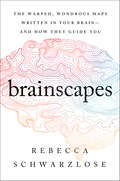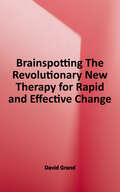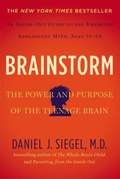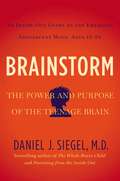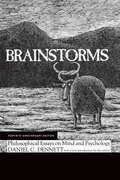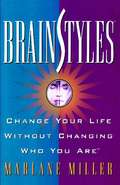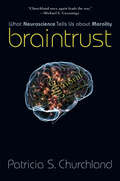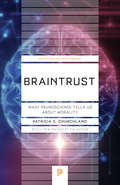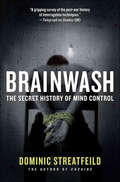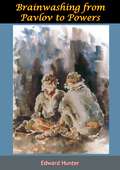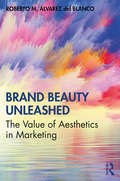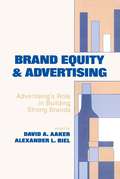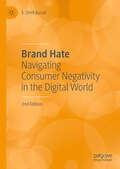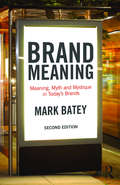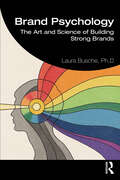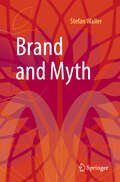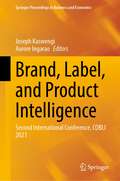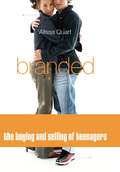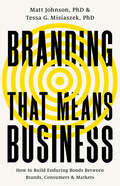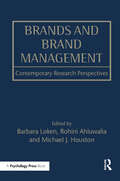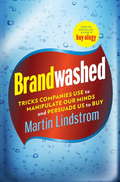- Table View
- List View
Brains, Buddhas, and Believing: The Problem of Intentionality in Classical Buddhist and Cognitive-Scientific Philosophy of Mind
by Dan ArnoldPremodern Buddhists are sometimes characterized as veritable "mind scientists" whose insights anticipate modern research on the brain and mind. Aiming to complicate this story, Dan Arnold confronts a significant obstacle to popular attempts at harmonizing classical Buddhist and modern scientific thought: since most Indian Buddhists held that the mental continuum is uninterrupted by death (its continuity is what Buddhists mean by "rebirth"), they would have no truck with the idea that everything about the mental can be explained in terms of brain events. Nevertheless, a predominant stream of Indian Buddhist thought, associated with the seventh-century thinker Dharmakirti, turns out to be vulnerable to arguments modern philosophers have leveled against physicalism.By characterizing the philosophical problems commonly faced by Dharmakirti and contemporary philosophers such as Jerry Fodor and Daniel Dennett, Arnold seeks to advance an understanding of both first-millennium Indian arguments and contemporary debates on the philosophy of mind. The issues center on what modern philosophers have called intentionality—the fact that the mind can be about (or represent or mean) other things. Tracing an account of intentionality through Kant, Wilfrid Sellars, and John McDowell, Arnold argues that intentionality cannot, in principle, be explained in causal terms.Elaborating some of Dharmakirti's central commitments (chiefly his apoha theory of meaning and his account of self-awareness), Arnold shows that despite his concern to refute physicalism, Dharmakirti's causal explanations of the mental mean that modern arguments from intentionality cut as much against his project as they do against physicalist philosophies of mind. This is evident in the arguments of some of Dharmakirti's contemporaneous Indian critics (proponents of the orthodox Brahmanical Mimasa school as well as fellow Buddhists from the Madhyamaka school of thought), whose critiques exemplify the same logic as modern arguments from intentionality. Elaborating these various strands of thought, Arnold shows that seemingly arcane arguments among first-millennium Indian thinkers can illuminate matters still very much at the heart of contemporary philosophy.
Brainscapes: The Warped, Wondrous Maps Written in Your Brain—And How They Guide You
by Rebecca SchwarzloseAn exploration of how perception, thought, and action are products of maps etched into your brain—and how technology can use them to read your mind.Your brain is a collection of maps. That is no metaphor: scrawled across your brain’s surfaces are actual maps of the sights, sounds, and actions that hold the key to your survival. Scientists first began uncovering these maps over a century ago, but we are only now beginning to unlock their secrets—and comprehend their profound impact on our lives. Brain maps distort our experience of the world, shape how we think and imagine, and open the door to mind-reading technologies. Their idiosyncrasies shine a light on our past and offer clues to our possible futures. In Brainscapes, Rebecca Schwarzlose combines unforgettable real-life stories, cutting-edge research, and vivid illustrations to reveal brain maps’ surprising lessons about our place in the world—and about the world’s place within us.Praise for Brainscapes“A profoundly illuminating account of how the brain works. . . . Rebecca Schwarzlose is a neuroscientist with a novelist’s literary flair.” —Cass R. Sunstein, author of Too Much Information“Deeply enjoyable and thoroughly researched. . . . Schwarzlose’s presentation of cutting-edge science is consistently accessible and precise.” —Publishers Weekly (starred review)“Brainscapes will change how you think about the brain and how you understand your own mind.” —Tali Sharot, author of The Influential Mind
Brainspotting: The Revolutionary New Therapy for Rapid and Effective Change
by David GrandBrain-based therapy is the fastest-growing area in the field of psychological health because it has proven that it can immediately address issues that talk therapy can take years to heal. Now Dr. David Grand presents the next leap forward in psychological care―combining the strengths of brain-based and talk therapies into a powerful technique he calls Brainspotting. In Brainspotting, Dr. Grand reveals the key insight that allowed him to develop this revolutionary therapeutic tool: that where we look reveals critical information about what's going on in our brain. Join him to learn about: <p>• The history of Brainspotting―how it evolved from EMDR practice as a more versatile tool for brain-based therapy <p>• Brainspotting in action―case studies and evidence for the effectiveness of the technique <p>• An overview of the different aspects of Brainspotting and how to use them <p>• Between sessions―how clients can use Brainspotting on their own to reinforce and accelerate healing <p>• Why working simultaneously with the right and left brain can lead to expanded creativity and athletic performance <p>• How Brainspotting can be used to treat PTSD, anxiety, depression, addiction, physical pain, chronic illness, and much more <p><p> "Brainspotting lets the therapist and client participate together in the healing process," explains Dr. Grand. "It allows us to harness the brain's natural ability for self-scanning, so we can activate, locate, and process the sources of trauma and distress in the body." With Brainspotting, this pioneering researcher introduces an invaluable tool that can support virtually any form of therapeutic practice―and greatly accelerate our ability to heal.
Brainstorm: Detective Stories from the World of Neurology
by Suzanne O'SullivanA leading neurologist recounts some of her most astonishing, challenging cases, which demonstrate how crucial the study of epilepsy has been to our understanding of the brain.Brainstorm follows the stories of people whose medical diagnoses are so strange even their doctor struggles to know how to solve them. A man who sees cartoon characters running across the room; a girl whose world suddenly seems completely distorted, as though she were Alice in Wonderland; another who transforms into a ragdoll whenever she even thinks about moving.The brain is the most complex structure in the universe. Neurologists must puzzle out life-changing diagnoses from the tiniest of clues, the ultimate medical detective work. In this riveting book, Suzanne O'Sullivan takes you with her as she tracks the clues of her patients' symptoms. It's a journey that will open your eyes to the unfathomable intricacies of our brains and the infinite variety of human experience.
Brainstorm: The Power and Purpose of the Teenage Brain
by Daniel J. SiegelBetween the ages of 12 and 24, the brain changes in important, and oftentimes maddening, ways. It’s no wonder that many parents approach their child’s adolescence with fear and trepidation. According to renowned neuropsychiatrist Daniel Siegel's New York Times bestseller Brainstorm, if parents and teens can work together to form a deeper understanding of the brain science behind all the tumult, they will be able to turn conflict into connection and form a deeper understanding of one another. In Brainstorm, Siegel illuminates how brain development impacts teenagers’ behavior and relationships. Drawing on important new research in the field of interpersonal neurobiology, he explores exciting ways in which understanding how the teenage brain functions can help parents make what is in fact an incredibly positive period of growth, change, and experimentation in their children’s lives less lonely and distressing on both sides of the generational divide.
Brainstorm: The Power and Purpose of the Teenage Brain
by Daniel J. SiegelIn this New York Times-bestselling book, Dr. Daniel Siegel shows parents how to turn one of the most challenging developmental periods in their children's lives into one of the most rewarding. Between the ages of 12 and 24, the brain changes in important, and oftentimes maddening, ways. It's no wonder that many parents approach their child's adolescence with fear and trepidation. According to renowned neuropsychiatrist Daniel Siegel's New York Times bestseller Brainstorm, if parents and teens can work together to form a deeper understanding of the brain science behind all the tumult, they will be able to turn conflict into connection and form a deeper understanding of one another. In Brainstorm, Siegel illuminates how brain development impacts teenagers' behavior and relationships. Drawing on important new research in the field of interpersonal neurobiology, he explores exciting ways in which understanding how the teenage brain functions can help parents make what is in fact an incredibly positive period of growth, change, and experimentation in their children's lives less lonely and distressing on both sides of the generational divide. Brainstorm is a current nominee for a Books for a Better Life award.
Brainstorms, Fortieth Anniversary Edition: Philosophical Essays on Mind and Psychology (The\mit Press Ser.)
by Daniel C. DennettAn anniversary edition of a classic in cognitive science, with a new introduction by the author.When Brainstorms was published in 1978, the interdisciplinary field of cognitive science was just emerging. Daniel Dennett was a young scholar who wanted to get philosophers out of their armchairs—and into conversations with psychologists, linguists, computer scientists. This collection of seventeen essays by Dennett offers a comprehensive theory of mind, encompassing traditional issues of consciousness and free will. Using careful arguments and ingenious thought experiments, the author exposes familiar preconceptions and hobbling intuitions. The essays are grouped into four sections: “Intentional Explanation and Attributions of Mentality”; “The Nature of Theory in Psychology”; “Objects of Consciousness and the Nature of Experience”; and “Free Will and Personhood.”This anniversary edition includes a new introduction by Dennett, “Reflections on Brainstorms after Forty Years,” in which he recalls the book's original publication by Harry and Betty Stanton of Bradford Books and considers the influence and afterlife of some of the essays. For example, “Mechanism and Responsibility” was Dennett's first articulation of his concept of the intentional stance; “Are Dreams Experiences?” anticipates the major ideas in his 1991 book Consciousness Explained; and “Where Am I?” has been variously represented in a BBC documentary, a student's Javanese shadow puppet play, and a feature-length film made in the Netherlands, Victim of the Brain.
Brainstorms: Philosophical Essays on Mind and Psychology
by Daniel Clement DennettDiscussions on artificial intelligence, philosophy, and cognitive psychology.
Brainstyles
by Marlane MillerStop trying to change yourself and fully develop who you really are--that's the message of this unique self-help book, which empowers readers to use their natural strengths to grow in limitless ways. Line drawings throughout.
Braintrust: What Neuroscience Tells Us About Morality
by Patricia S. ChurchlandWhat is morality? Where does it come from? And why do most of us heed its call most of the time? In Braintrust, neurophilosophy pioneer Patricia Churchland argues that morality originates in the biology of the brain. She describes the "neurobiological platform of bonding" that, modified by evolutionary pressures and cultural values, has led to human styles of moral behavior. The result is a provocative genealogy of morals that asks us to reevaluate the priority given to religion, absolute rules, and pure reason in accounting for the basis of morality. Moral values, Churchland argues, are rooted in a behavior common to all mammals--the caring for offspring. The evolved structure, processes, and chemistry of the brain incline humans to strive not only for self-preservation but for the well-being of allied selves--first offspring, then mates, kin, and so on, in wider and wider "caring" circles. Separation and exclusion cause pain, and the company of loved ones causes pleasure; responding to feelings of social pain and pleasure, brains adjust their circuitry to local customs. In this way, caring is apportioned, conscience molded, and moral intuitions instilled. A key part of the story is oxytocin, an ancient body-and-brain molecule that, by decreasing the stress response, allows humans to develop the trust in one another necessary for the development of close-knit ties, social institutions, and morality. A major new account of what really makes us moral, Braintrust challenges us to reconsider the origins of some of our most cherished values.
Braintrust: What Neuroscience Tells Us about Morality (Princeton Science Library)
by Patricia S. ChurchlandWhat is morality? Where does it come from? And why do most of us heed its call most of the time? In Braintrust, neurophilosophy pioneer Patricia Churchland argues that morality originates in the biology of the brain. She describes the "neurobiological platform of bonding" that, modified by evolutionary pressures and cultural values, has led to human styles of moral behavior. The result is a provocative genealogy of morals that asks us to reevaluate the priority given to religion, absolute rules, and pure reason in accounting for the basis of morality. Moral values, Churchland argues, are rooted in a behavior common to all mammals--the caring for offspring. The evolved structure, processes, and chemistry of the brain incline humans to strive not only for self-preservation but for the well-being of allied selves--first offspring, then mates, kin, and so on, in wider and wider "caring" circles. Separation and exclusion cause pain, and the company of loved ones causes pleasure; responding to feelings of social pain and pleasure, brains adjust their circuitry to local customs. In this way, caring is apportioned, conscience molded, and moral intuitions instilled. A key part of the story is oxytocin, an ancient body-and-brain molecule that, by decreasing the stress response, allows humans to develop the trust in one another necessary for the development of close-knit ties, social institutions, and morality. A major new account of what really makes us moral, Braintrust challenges us to reconsider the origins of some of our most cherished values.
Brainwash: The Secret History of Mind Control
by Dominic StreatfeildVivid and disturbing, Brainwash is essential insight into the modern practice of interrogation and torture. With access to formerly classified documentation and interviews from the CIA, U.S. Army, MI5, MI6, and British Intelligence Corps, Dominic Streatfeild traces the evolution of mind control from its origins in the Cold War to the height of today's war on terror. Behind the front lines of every war in the world, prisoners are forced to sit for interrogation: manipulated, coerced, and sometimes tortured--often without ever being touched. Brainwash is a history of the methods intended to destroy and reconstruct the minds of captives, to extract information, convert dissidents, and lead peaceful men to kill and be killed.
Brainwashing from Pavlov to Powers
by Edward HunterIntelligence agency veteran and journalist Edward Hunter shares the experiences of men he interviewed who were subject to brainwashing as prisoners in totalitarian communist societies.A shocking yet informative expose of the history and techniques of brainwashing by communist military and security services, this book commences by delving into the origins of the practice. Ivan Pavlov, a vaunted scientist in the Soviet Union, was an unwitting aide to the process—his experiments on animals, and the discoveries he made therein, would form the basis of the incarceration and interrogation methods used in multiple communist states. The object of such procedures was to break down a person's ego, and rebuild it in the form of an unwavering supporter to communist ideology.Chapter by chapter, we are given a detailed guide to the physical and mental manipulations which comprise brainwashing. Supporting this information are multiple interviews and accounts of prisoners who lived to tell of their ordeals. Some of these men are intellectuals, persecuted for their mental prowess, while others are captured soldiers. Many retained their sanity by discovering ways to subvert the process—the harsh interviews, replete with threats, were rebuffed. In short, the playbook of the brainwasher is exposed as having exploitable flaws and weaknesses.Although the subject is by nature grim and dark, Edward Hunter's narration is interspersed with humorous narratives. The experiences of British and American POWs during the Korean War are humorous; to the bafflement of their guards, men would feign insanity and pretend to be hallucinating, be it through having an illusory girlfriend or riding a non-existent bicycle. The sense of camaraderie did much to strengthen the resolve of these soldiers, in spite of the adverse conditions of their camp.-Print ed.
Brainwashing: The Story Of Men Who Defied It
by Edward HunterFirst published in 1956, this book by U.S. journalist and intelligence agent Edward Hunter comprises dramatic first-hand accounts from Korean War veterans who survived P.O.W. camps and Communist attempts to brainwash them."The new word brainwashing entered our minds and dictionaries in a phenomenally short time. [...] The reason the word was picked up so quickly was that it was not just a clever synonym for something already known, but described a strategy that had yet no name. [...] The word came out of the sufferings of the Chinese people. Put under a terrifying combination of subtle and crude mental and physical pressures and tortures, they detected a pattern and called it brainwashing. [...] What they had undergone was more like witchcraft, with its incantations, trances, poisons, and potions, with a strange flair of science about it all, like a devil dancer in a tuxedo, carrying his magic brew in a test tube."A true and terrible story of the men who endured and defied the most diabolical red torture--the war book you will never forget."A fascinating document."--Chicago Tribune
Brand Beauty Unleashed: The Value of Aesthetics in Marketing
by Roberto M. Álvarez del BlancoThis book presents an in-depth, careful study of our understanding of the concept of beauty in everyday objects and its impact on markets and brands. Moving beyond artistic notions of beauty, it demonstrates how beauty is an asset that can be leveraged in the marketplace. Traditionally, beauty has been examined in relation to its influence on painting, sculpture, literature, music, and architecture. However, its value and power in the marketplace is understudied. Álvarez del Blanco provides a systematic analysis of beauty in commonplace objects and brands, drawing on cutting-edge research at the intersection of marketing and neurosciences. Through examining the neuroscientific evidence for how the brain processes beauty, the author articulates the implications this may have on marketing and brand management. He also offers a glimpse of how beauty may evolve, and its marketing implications for firm strategy in the coming decades. Written by a recognized authority in marketing and brand strategy, Brand Beauty Unleashed gives students with an interest in marketing, consumer behavior, branding, and neuromarketing an exciting new perspective on this intangible asset.
Brand Equity & Advertising: Advertising's Role in Building Strong Brands (Advertising And Consumer Psychology Ser.)
by David A. Aaker Alexander L. BielThe tenth annual Advertising and Consumer Psychology Conference held in San Francisco focused on branding -- a subject generating intense interest both in academia and in the "real world." The principle theory behind these conferences is that much can be gained by joining advertising and marketing professionals with academic researchers in advertising. Professionals can gain insight into the new theories, measurement tools and empirical findings that are emerging, while academics are stimulated by the insights and experience that professionals describe and the research questions that they pose. This book consists of papers delivered by experts from academia and industry discussing issues regarding the role of advertising in the establishment and maintenance of brand equity -- making this volume of interest to advertising and marketing specialists, as well as consumer and social psychologists.
Brand Hate: Navigating Consumer Negativity in the Digital World
by S. Umit KucukThis book focuses on the concept of “brand hate” and consumer negativity in today’s digital markets. It explores the emotional detachment consumers generate against valued brands and how negative experiences affect their and other consumers' loyalty. It is almost impossible not to run into hateful language about companies and their brands in today’s digital consumption spaces. Consumer hostility and hate is not hidden and silent anymore but is now openly shared on many online anti-brand websites, consumer social networking sites, and complaint and review boards. The book defines consumer brand hate and discusses its dimensions, antecedents, and consequences as well as the semiotics and legality of such brand hate activities based on current brand dilution arguments. It describes the situations which lead to anti-branding and how consumers choose to express their dissatisfaction with a company on individual and social levels. This newly updated edition discusses recent research findings from brand hate literature with new cases and extended managerial analysis. Thus, the book provides strategic perspectives on how to handle such situations to achieve better functioning markets for scholars and practitioners in marketing, psychology, and consumer behavior.
Brand Meaning: Meaning, Myth and Mystique in Today’s Brands
by Mark BateyThis second edition of Brand Meaning lays out new territory for the understanding of how brands both acquire and provide meaning. The author draws on his experience with leading international companies to propose a compelling framework for the conscious and unconscious ways in which people connect with products and brands. Revised and updated, it contains contemporary as well as classic examples of brand meaning in practice from various countries, and expands on the theory, methods and applications of brand meaning. The book’s multidisciplinary approach and concise yet comprehensive content makes it an ideal supplemental reader for undergraduate, graduate, and MBA courses, as well as valuable reading for practitioners in the fields of marketing, advertising and consumer research. For more information, visit www.brandmeaning.com.
Brand Psychology: The Art and Science of Building Strong Brands
by Laura BuscheBrand Psychology brings together theory and practice from the fields of psychology, design, and marketing to demystify the brand development process. It explores the behavioral science behind brand building, looking at the psychological principles at play whenever a brand is built and communicated. Backed by research from various fields of psychology, the book presents practical insights for developing memorable brands through its interdisciplinary character, and emphasis on digital channels. Throughout the book, readers will learn to apply concepts from brand psychology, social learning and persuasion, identity design, and sensory branding to attract and retain their ideal customers. Each chapter presents insights from academic consumer behavior studies, real-life cases from inspiring brands, and unique visual learning tools including infographics, worksheets, and timelines. Ultimately, it serves as a tool to bridge the gap between scientists and entrepreneurs, offering clear, research-backed ideas to drive brand growth and reach human beings in a meaningful way during a time of independent brands and global connectivity. This transformative book shows readers how to: Develop memorable brands that resonate with their target audience Create powerful brand stories, archetypes, and strategies for growth Navigate brand management with mindful communication and active shaping of associations Containing cutting-edge brand-building tools, this book is a must-read for students and practitioners in brand management, marketing, design management, graphic design, business, advertising, and related spaces that aim to craft an identity that turns heads and hearts.
Brand and Myth
by Stefan WallerBrand and Myth A Cultural-Philosophical Consideration Brands reflect the desires of the modern individual. In Nike, it’s the hope of achieving success by simply doing it; in a Mercedes, it’s the pursuit of status; and in a MasterCard, it encapsulates the longing for those moments that cannot be bought with money (but for which you still need money). The list can go on for a long time. Despite the fact that these brand messages are understood across various cultures, they have played a secondary role in cultural-philosophical debates. To professional thinkers, brands appear, at best, as banal and, at worst, as instruments in a malign illusionary context. They are seen as expressions of capitalism, something to be viewed critically, and thus rejected. From a more neutral standpoint, the engagement with brands is understood as a subject of business administration, marketing, and design, and therefore considered outside of one’s own area of expertise.
Brand, Label, and Product Intelligence: Second International Conference, COBLI 2021 (Springer Proceedings in Business and Economics)
by Joseph Kaswengi Aurore IngaraoThis book contains the latest and most up-to-date research results from the fields of brands, labels and product, presented at the international colloquium COBLI 2021, held in Orleans, France. It covers a wide range of topics from the fields of economics, psychology, information technology and social sciences. In particular, the book deals with various areas of application such as consumer behavior in the omnichannel, the influence of the coronavirus pandemic on attitudes and customer behavior, franchising, origin labelling, transparency in the agri-food industry, tourism and the triptych of brand/label/product. The contributions are gathered under the following main topics: Consumer behavior and decisions, labeling strategy, brand market trends, branding of local brands, territorial impact on brand/label/product, theoretical and managerial research methods.
Branded: The Buying and Selling of Teenagers
by Alissa QuartAlissa Quart takes the reader into the disturbing world of teen marketing, showing how they are taught to market to each other and where adults build careers out of insinuating their way into friendships with teens in order to monitor what they wear, eat, listen to and talk about.
Branding that Means Business: How to Build Enduring Bonds between Brands, Consumers and Markets
by Matt Johnson Tessa G MisiaszekA revelatory guide on how to build, sustain and grow a brand. A brand is either beloved, or it&’s noise. We live in a fast-paced world of immediate gratification where consumers can listen to any song, watch any movie, or read any article, with the touch of a few buttons. They are peppered with hyper-personalized targeting for products that can be ordered seamlessly and arrive within hours. And if your brand isn&’t the first to come to mind, they&’ll click that button and it&’ll be delivered by someone else. So how do you make sure your brand connects with consumers? Branding that Means Business draws from the authors&’ experience and business literature as well as psychology, sociology, and even anthropology to show readers that while any brand serves the business, the mechanisms that enable it are all about connecting with people. Readers will learn how to create, maintain, and operationalize their brand, and think creatively about how to differentiate their product and most importantly, make consumers fall in love with it.
Brands and Brand Management: Contemporary Research Perspectives (Marketing And Consumer Psychology Ser.)
by Barbara Loken Rohini Ahluwalia Michael J. HoustonVery few books exist that meaningfully integrate the rich and vast body of scientific research and theories that have accumulated in the field, relating to both traditional and contemporary topics in branding. This book accomplishes that task, with contributions from leading experts in the science of branding, national and international. The book should appeal to all students, faculty, and marketing professionals with an interest in research findings about brands, and an interest in deepening their understanding of how consumers view brands.
Brandwashed: Tricks Companies Use to Manipulate Our Minds and Persuade Us to Buy
by Martin LindstromForeword by Morgan SpurlockFrom the bestselling author of Buyology comes a shocking insider's look at how today's global giants conspire to obscure the truth and manipulate our minds, all in service of persuading us to buy. Marketing visionary Martin Lindstrom has been on the front lines of the branding wars for over twenty years. Here, he turns the spotlight on his own industry, drawing on all he has witnessed behind closed doors, exposing for the first time the full extent of the psychological tricks and traps that companies devise to win our hard-earned dollars. Picking up from where Vance Packard's bestselling classic, The Hidden Persuaders, left off more than half-a-century ago, Lindstrom reveals: * New findings that reveal how advertisers and marketers intentionally target children at an alarmingly young age - starting when they are still in the womb! * Shocking results of an fMRI study which uncovered what heterosexual men really think about when they see sexually provocative advertising (hint: it isn't their girlfriends). * How marketers and retailers stoke the flames of public panic and capitalize on paranoia over global contagions, extreme weather events, and food contamination scares. * The first ever neuroscientific evidence proving how addicted we all are to our iPhones and our Blackberry's (and the shocking reality of cell phone addiction - it can be harder to shake than addictions to drugs and alcohol). * How companies of all stripes are secretly mining our digital footprints to uncover some of the most intimate details of our private lives, then using that information to target us with ads and offers 'perfectly tailored' to our psychological profiles. * How certain companies, like the maker of one popular lip balm, purposely adjust their formulas in order to make their products chemically addictive. * What a 3-month long guerilla marketing experiment, conducted specifically for this book, tells us about the most powerful hidden persuader of them all. * And much, much more. This searing expose introduces a new class of tricks, techniques, and seductions - the Hidden Persuaders of the 21st century- and shows why they are more insidious and pervasive than ever. From the Hardcover edition.

